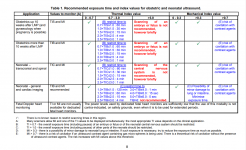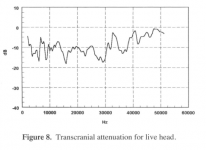Unborn babies in the womb listen to the world around them with ultrasound. The process of birth deafens them. Sound travels through air water and skin. What is an ear but an organised piece of skin. We listen through our skin as well as our ears. Skin will hear ultrasound while the adult ear will not.
Just thoughts. Tos
I didn't notice any unborn baby covering his ears, or otherwise protesting, during a pregnancy ultrasound exam. Did you?
I didn't notice any unborn baby covering his ears, or otherwise protesting, during a pregnancy ultrasound exam. Did you?
As an educated layman, what I would call ‘ultrasound’ is what I can no longer hear with my own two ears. 🙂
Unborn children can hear up to around 25-30khz, and have excellent hearing and 3D spatial perception of the world beyond the womb. Technically speaking, ultrasound as such starts at around 50khz. Therefore unborn babies cannot hear ultrasound waves during a prenatal womb scan.
Doctors know this. I know this, and now you know this.
Perhaps under the all seeing eye of Sauron, I should have made myself clearer. 😱
ToS
I do trust those who base their audio belief on proof.It might be for some people and or under some circumstances. The most important thing is probably not an admission, but some willingness to adjust one's position as one learns more.
Unfortunately, lay people prefer and have greater trust in experts who are absolutely certain in their beliefs
As for your belief on high end DACs sounding different, is it based on proof?
As an educated layman, what I would call ‘ultrasound’ is what I can no longer hear with my own two ears. 🙂
Unborn children can hear up to around 25-30khz, and have excellent hearing and 3D spatial perception of the world beyond the womb. Technically speaking, ultrasound as such starts at around 50khz. Therefore unborn babies cannot hear ultrasound waves during a prenatal womb scan.
Doctors know this. I know this, and now you know this.
Perhaps under the all seeing eye of Sauron, I should have made myself clearer. 😱
ToS
Oh well, another theory shot down. 😛
Unborn babies in the womb listen to the world around them with ultrasound. The process of birth deafens them. Sound travels through air water and skin.
You may skip that “ultra”
Maybe the folks that can’t hear the subtleties (95%’ers) were victims of ultrasonic imaging abuse......deafening the poor little fetus ears! 😀
There wasn’t fetal ultrasound examination here when I was an embryo. How can my hearing be that bad then?😀
P.S.Ultrasound was first used for clinical purposes in 1956 in Glasgow (Obstetrician Ian Donald and engineer Tom Brown)
Attachment from:
https://www.bmus.org/static/uploads...y-Guidelines-2009-revision-FINAL-Nov-2009.pdf
George
Attachments
What relevance has evidence of brain activity caused by ultrasonic sound shown in fMRI scans to do with how we perceive stereo audio reproduction in our rooms?
Oohashi et al. did not use fMRI but PET scans and EEG instead.
On an individual basis I've often asked what any consumer is supposed to do if somebody, somewhere, somehow gets a positive result for "whatever" in controlled listening tests. Has he to buy immediately the new "whatever" or should he still try to find out if it of relevance to him?
If the latter is true, does he need external test results at all?
Beside that, it is interesting if there is robust evidence for physiological reaction to "inaudible" high-frequency sounds imo even more so as Oohashi et al. combined the imaging techniques with a more traditional sensory experiment.
I had a little bet with myself that you would say that 🙄 Still somebody, probably Robin, mentioned fMRI. Where are these ultrasonic frequencies coming from?Oohashi et al. did not use fMRI but PET scans and EEG instead.
@Jakob: I hope there was not an intermodulation in driver acoustical output again.
BTW, ear is pretty nonlinear as well. However, it is very difficult for ultrasound to reach into sensory system through ear canal, membrane to cochlea and I think you know this.
BTW, ear is pretty nonlinear as well. However, it is very difficult for ultrasound to reach into sensory system through ear canal, membrane to cochlea and I think you know this.
JAES or AES conference papers/presentations? JAES is peer-reviewed, but their conference papers are only sometimes. I'd guess you know what impact factors are, right? JAES is very low.
If you get a chance, that would be great. No rush. The thread *does* zoom by... no worries.
I'll do what I can, but it will not be timely in response (probably just pm you and Jakob). I do remember a few of them being full blown papers rather than conference proceedings.
I give very very little weight to impact factor as it is heavily manipulable, and benefits wide reaching journals rather than specialist journals. In other words, the correlation between quality of paper/journal and it's citations/impact factor is tenuous at best. Some of the best work in my field gets shunted into "lesser" journals with low impact factor because it's not interesting to most folks, but is the real meat and potatoes type work that moves the field forward.
Last edited:
He should find out if it is true or just another one of those marketing hypes.On an individual basis I've often asked what any consumer is supposed to do if somebody, somewhere, somehow gets a positive result for "whatever" in controlled listening tests. Has he to buy immediately the new "whatever" or should he still try to find out if it of relevance to him?
Why does it have to be external test results when basic knowledge in audio electronics can filter out most of those hypes at the "doorstep", i.e. high end DACs & amps sounding better, expensive audio cables.If the latter is true, does he need external test results at all?
BTW, ear is pretty nonlinear as well. However, it is very difficult for ultrasound to reach into sensory system through ear canal, membrane to cochlea and I think you know this.
Not through the air but through bone conduction
http://www.tinnitusjournal.com/arti...-sound-in-the-audiometricultrasonic-range.pdf
George
Attachments
I had a little bet with myself that you would say that 🙄 Still somebody, probably Robin, mentioned fMRI. Where are these ultrasonic frequencies coming from?
Your question; as you should have read the publication you shouldn't imo blame another one for this.
Beside that, anything wrong with providing the correct information instead of spreading further the false one? 😉
Wrt to the new question, may I suggest that you read Oohashi et al.'s publication from 2000 now?
@ PMA,
@Jakob: I hope there was not an intermodulation in driver acoustical output again.
Using the crystal ball again? 🙂
, ear is pretty nonlinear as well. However, it is very difficult for ultrasound to reach into sensory system through ear canal, membrane to cochlea and I think you know this.
I thought you'd able to accept (maybe even admit) that you've posted incorrect informations and conclusions:
He did. The content with both <22kHz and >22kHz frequencies was distinguishable from that with only =<22kHz file only in case that it was tested through speaker with one driver. Not distinguishable when tested through a 2-way speaker with 2 drivers.
There ones was a PMA posting around here who was interested in correct information, not so much today unfortunately.
And wrt your question, yes i know and surprisingly that is exactly the reason why I found Oohashi et al.'s results so interesting.
@Evenharmonics,
<snip>
Why does it have to be external test results when basic knowledge in audio electronics can filter out most of those hypes at the "doorstep", i.e. high end DACs & amps sounding better, expensive audio cables.
You simply must start reading some literature on sensory tests to get over Peter Aczel's opinion paper, which seems - as questionable its content is, remember the statistical validity issue? - to be your lonely reference.
Btw, you still haven't brought up the evidence for your claim from 9th of June....
Your question; as you should have read the publication you shouldn't imo blame another one for this.
Beside that, anything wrong with providing the correct information instead of spreading further the false one? 😉
Wrt to the new question, may I suggest that you read Oohashi et al.'s publication from 2000 now?
The thing is, I asked a question, I didn't reference that publication. I'm presuming there is no ultrasonic frequencies in stereo recordings, I can conclude that there is no relevance to stereo audio reproduction in the home environment. Why would I waste my time reading that paper?
The World Beyond 20kHz
I’m not sure if 24/96 (or similar) is recorded with extended upper range.... Is it?
I’m not sure if 24/96 (or similar) is recorded with extended upper range.... Is it?
You simply have to cite a proof that listeners miss out audible difference during level matched audio DBT due to the stress and when the stress is removed, they can hear it in level matched audio DBT. I asked you this before but you have yet to provide a proof. All you provided was more of your opinion.You simply must start reading some literature on sensory tests to get over Peter Aczel's opinion paper, which seems - as questionable its content is, remember the statistical validity issue? - to be your lonely reference.
I did cite evidence by quoting the title of the thread and some of your own replies on Hydrogenaudio. You will have to point out with quotes why that thread doesn't qualify as evidence.Btw, you still haven't brought up the evidence for your claim from 9th of June....
The thing is, I asked a question, I didn't reference that publication.
Sure, let's pretend for a moment that context doesn't matter, so you're correct and I apologize.
I'm presuming there is no ultrasonic frequencies in stereo recordings, I can conclude that there is no relevance to stereo audio reproduction in the home environment. Why would I waste my time reading that paper?
Aren't you wasting some (even a lot of) time already?
Why not spending some and give it a chance to learn a bit so that it might be even a win at the end? 🙂
(Admitted that presuming is a lot easier, though)
Last edited:
Not as much as youAren't you wasting some (even a lot of) time already?
Why would I waste my time reading that paper?
You'd be much better (informed, educated, etc...) by reading this and the links.
Now waiting for Jakob(x) to grumble, moan, insult the unwashed masses, quote 1000 pages of irrelevant literature, obfuscate, spread FUD, etc... and, if everything else fails, self-victimize.
- Status
- Not open for further replies.
- Home
- Member Areas
- The Lounge
- John Curl's Blowtorch preamplifier part III

